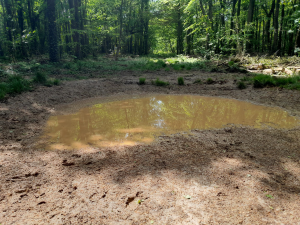Case study: Headstone Copse Pond Restoration
Background
Headstone Copse, now known by the landowner as Claire’s Copse, is a small, heavily wooded copse situated on the northern fringes of Hambledon on the south westerly border of the South Downs National Park.
Its name originates from 1782; a local gentleman was tragically murdered, and a headstone was placed to mark the spot where he died.
The woodland is owned and managed by a landowner whose aim is to restore biodiversity through sympathetic woodland management.
Within the wood was an existing on- site pond which never held water for longer than a week or two. The SDNPA Western Ranger team were called upon to restore the pond supporting the local wildlife and boost biodiversity.
In December 2022, Rangers visited the site to scope out how to restore the pond to hold water. It was decided that the best method was to use a Bentonite clay powder.
On contact with water, Bentonite expands, transforming into a thick gel that seals the soil making it watertight. In contrast to a traditional butyl liner, it can also ‘self- heal’, expanding around the small gaps and crevices in the soil.
Bentonite powder was also considered to be the most practical option in terms of being able to access a remote location in the centre of the copse.
The cost of the project at £2,371 was partly funded by SDNPA with a contribution from the landowner.
The Project
To prepare for the pond restoration, some of the nearby trees that circled the pond had to be coppiced and felled including some smaller hazel and more significant sycamore and beech. The removal and thinning of trees allows the pond to function as a healthy habitat by providing 4 – 6 hours of light per day or approx. 1/3 of the pond in sunshine in daylight hours. This tree work was completed prior to the bird nesting season and completed by one of our well trusted contractors.
Restoration work continued on the ground, clearing away the top surface of silt and leaf litter. Whilst there were a few challenges, such as getting the mini digger stuck in the heavy mud, these were quickly overcome by working out new routes to access the pond.
Delivery work was completed in collaboration with our pond consultant, allowing the Ranger Team present to learn how the bentonite powder can be applied to ensure the best possible outcome for the pond. The initial ground preparation took approx. 2.5 days to complete. This included the pond surface clearance and general maintenance, plus setting the pond levels and gradients in order to gain the optimum ‘sticking potential’ of the powder to bind to the bare earth surface.
The final stage of the restoration was to spread the 25 bags of Bentonite powder onto the prepared surface of the pond. This was an ‘all hands to the
deck’ approach with the bags being sited within the pond and spread at around 5cm depth to give good coverage. The final stages were to stamp in or, in this case, utilise the tracks of the digger, to bed the powder into the structure of the soil. With the pond restoration complete, the landowner has also sown some wildflower seed to re-establish the pondside vegetation.
My aim has always been to increase biodiversity into this woodland. I always knew a pond was essential.
Within days of the plastic free pond filling up, nature began to find it, including a few newts that returned. I am most grateful and looking forward to this priceless habitat evolving.
Landowner of Claire’s copse
The Outcome
By restoring the pond at Headstone Copse (Claire’s Copse) we have rejuvenated a failing woodland pond that will contribute towards nature recovery and ecological connectivity.
Within a few days we had some significant rainfall and the pond is now partially full.
Within those limited days of rainfall, a number of newts had already colonised the pond and there were numerous butterflies enjoying the minerals that were available. Early observations suggest that it will hold water all year round.
The project highlights the success of using less impactful materials, such as plastics, cement or even imported clay, all of which present future problems such as cracking, leaks, degradation or heavy transportation implications.
These are not the case with Bentonite clay powder.
It is a fine, dried powder that, when wetted, swells and absorbs the moisture to form a thick, sticky clay lining that is ideal for many ponds. It is also easier to transport to more remote locations.
We will continue to monitor the development of the pond and observe its levels as the months progress but hope to get a pond ‘full’ of water during the winter months.
The Future
Popular pond lining materials such as plastic, cement and rubber can be environmentally impactful .
This project has demonstrated an alternative, more ecologically friendly ,yet viable, lining solution by using Bentonite clay powder.
Indeed, as well as being sustainable and cost effective in the longer term, Bentonite can be used with a limestone ‘cap’ to replicate dew ponds that were constructed many years ago.
Additionally, if the water level fails due to a leak, the lining is easily repaired by adding more powder which will naturally find any cracks or holes and reseal the clay liner.
Our initial findings of using this lining construction method has been positive and would recommend its use in other pond delivery projects as an alternative solution.
For more information
Paul Bushell, South Downs Ranger: paul.bushell@southdowns.gov.uk


